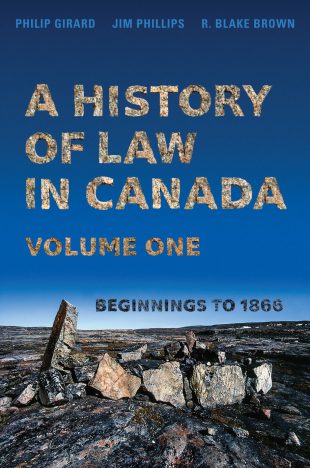By Philip Girard, Jim Phillips, and Blake Brown. Published by the University of Toronto Press.
This book, the first of 2 volumes, presents the history of law in what is now Canada, from the first European contacts with northern North America in the very early sixteenth century to immediately before Confederation. Divided into four parts, the book first looks at the roots of Canada’s three legal traditions, Indigenous, French and English, in North America, France and England. Part 2 examines the period down to 1701 and the signing of the treaty known as the Great Peace of Montreal in 1701, during which New France was established. Part 3 deals with the eighteenth century – Anglo-French conflict, New France until 1760, the establishment and growth of English colonies of settlement, and, throughout, relations with indigenous peoples and governance of indigenous nations. Part 4 is devoted to the British North American period, after 1815. Indigenous people are central of the narrative throughout, including after 1815 when their influence waned as their land base was largely lost in central and eastern Canada. Included in Part 4 are the Red River settlement and early British Columbia. Although the background to this history are the well-known major political, military, social and economic transformations of this part of North America, the book is principally a legal history set against and integrated with that background. Court systems, the judiciary, the legal professions, are dealt with in every period and for each of the legal traditions, and the areas of law covered include criminal, family, constitutional, commercial, land, succession, and civil and criminal procedure. This volume combines the remarkable flowering of scholarship on Canadian legal history, so much of it fostered and published by the Osgoode Society over 35 years, and much new research.
AWARDS
Honourable Mention – Canadian Law and Society Association Book Prize 2019
A History of Law in Canada Volume I was awarded an honourable mention for the W. Wesley Pue Book Prize given by the Canadian Law and Society Association in 2019. The citation for the award reads as follows: A History of Law in Canada, Volume One is a monumental and masterful work. It fills a gap in Canadian scholarship by providing a comprehensive, well-written and informative account of the history of law in Canada. Its 900 pages of text and footnotes reflect an astonishing range of knowledge. It breaks new ground in its sweep and scale, and its interweaving of the history of the three pillars of Canadian law: common law, civil law and Indigenous legal orders. It will be a classic for many years, a guide and inspiration to Canadian legal historians for generations to come.
REVIEWS OF A HISTORY OF LAW IN CANADA VOL I : BEGINNINGS TO 1866
The authors set themselves a daunting task in this admirable book, the initial offering in a longer ambitious project on the history of law in Canada. …. Their success is measured in an engaging and accessible argument that raises important questions about the colonial legacies that continue to shape and inform contemporary debate, policy, and interpretation of the law in Canada, especially at it relates to the country’s First Nations peoples…. The book offers two broad interpretative themes. The first is legal pluralism, which is read and applied in multiple and nuanced ways in the work. First, the authors construe the French and English legal worlds as pluralistic, given that both combined royal authority, traditional prescription, and customary norms. However, because our understanding of First Nations’ legal systems tends to be particular rather than general, it is difficult to state with certainty that their pre-contact legal systems functioned in a fashion that would have aligned with a European, let alone a contemporary, definition of legal pluralism. What can be said is that in their engagement with the European newcomers, specific North American First Nation communities certainly embraced a more Western style of legal pluralism…. The second theme is liberty and order. Here too is a fine balance. From a European perspective, much of early North American social, political, economic, and legal history turned on questions of liberty and order. As the book demonstrates, within the various nations, as well as among those communities, absolutes entailing liberty or order were mercurial. How liberty might function meant something different for First Nations individuals, community leaders, habitants, French merchants, traders, and church officials. ….. Like legal pluralism, the interpretative theme of liberty and order contributed to challenging debates about the meanings of law and law reform as the British North American colonies became increasingly confident in the middle decades of the nineteenth century….. Authors Philip Girard, Jim Phillips, and R. Blake Brown have crafted a thought-provoking volume that should be required reading for all Canadian legal historians, and advised reading for anyone interested in northern North American legal history. Further, given its relevance to a variety of fields and subdisciplines, the book deserves the attention of any North American historian drawn to First Nations, colonial, social, political, or economic history. The book is well worth sustained attention. Jonathan Swainger, Law and History Review, Vol 38, 2020 , pp. 287-290
A History of Law in Canada … is a very ambitious undertaking….The authors begin their project with a general introduction to the idea of legal pluralism and the foundations of the three legal traditions that are the focus of their study. These introductory chapters serve as an excellent primer and provide a firm foundation on which the balance of the volume rests. They will be especially valuable for readers unfamiliar with legal history. The chapters that follow outline the law and its development in each of the three traditions over a period of roughly three and a half centuries, from the time of the arrival of Europeans in the lands that became Canada until the 1860s. The range of subjects addressed in these chapters is enormous, including law-making, the development and evolution of institutions, criminal law, family law, law relating to the economy, gender and race, and more besides….
The authors make a number of original contributions to the study of the history of law in Canada. The most obvious of these is the identification of three periods into which the legal history of the pre-Confederation era can be usefully divided: 1500–1701, 1701–1815, and 1815 to the 1860s. The reasons for the departure from better known watershed moments – Britain’s conquest of New France in 1763, for example – are persuasively argued and reflect the fact that development of the law has not always moved in lockstep with political, economic, or other aspects of Canadian history. … The identification of important themes within Canadian legal history and the critical surveying of the published literature relating to these themes is also a significant and valuable contribution, especially for readers unfamiliar with that substantial body of work. .. In sum, History of Law in Canada achieves the goals of its authors admirably. It contains a wealth of information on the three legal traditions of early Canada and is written in a style that is clear enough to be accessible to a wide range of readers and with a completeness and rigour that should satisfy scholars. Ken Leyton-Brown, Canadian Historical Review, Vol 101, 2020.
REVIEWS OF A HISTORY OF LAW IN CANADA VOL I: BEGINNIGS TO 1866 HAVE ALSO APPEARED IN:
Shelley Gavigan, Osgoode Hall Law Journal, Vol 58, 2021, pp. 719-725.
Philip Buckner, British Journal of Canadian Studies, Vol 32, 2019-2020, p. 154.
James Muir, Acadiensis, Vol 49, 2020, pp. 208-22.1
Jamie Benidickson, Canadian Journal of Law and Society, Vol 36, 2021, pp. 536-538.




